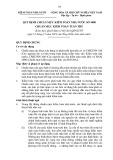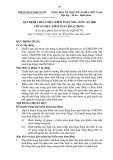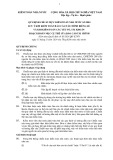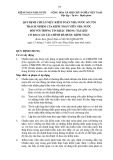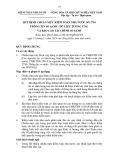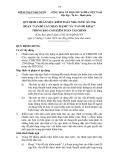
66
Journal of Economic and Banking Studies
No.8, Vol.4 (2), December 2024 pp. 66-78
©
Banking Academy of Vietnam
ISSN 2734 - 9853
Assessing the factors affecting the Vietnamese
intention to invest in cryptocurrency
Pham, Manh Hung1 - Vuong, Linh Nham2 - Nguyen, Thanh Tra3
Banking Academy of Vietnam1,2, National Economic University, Vietnam3
Corresponding Authors.
E-mail address: hungpm@hvnh.edu.vn (Pham, M.H.), linhnham@hvnh.edu.vn (Vuong, L.N.),
thanhtra23114@gmail.com (Nguyen, T.T.)
1. Introduction
The digital era has greatly facilitated the
development of innovative ideas related
to financial activities. Improvements
on the Internet or artificial intelligence, block-
chain, or cloud computing have become impor-
tant factors in reshaping the global economic
structure (Knapp, 2022). Regarding technol-
ogy advancement, financial activities such
as payments, online transactions, and invest-
ments have been revolutionized to give birth
to cryptocurrencies. According to Shoaib et al.
(2013), cryptocurrency is a form of virtual cur-
rency that employs blockchain technology and
encryption to safeguard the financial transac-
tions of its users. The blockchain technology
enables the creation of a unified transaction
ledger, necessitating each cryptocurrency user
to maintain an individualised version of the
ledger. Every new transaction is immediately
recorded as it occurs, and every copy of the
blockchain is simultaneously updated with the
new information. This is done to ensure that all
of the records are accurate and consistent with
one another. European Central Bank (2012) de-
fined cryptocurrency as a form of decentralised
digital currency that operated independently
from any central authority. Participants in a
particular online community are willing to use
this currency, which has been created and gov-
erned by its founders. The defining feature of
cryptocurrency is its lack of physical manifes-
tation, such as coins or cash, and its exclusive
use within the realm of the internet.
Bitcoin is the first cryptocurrency developed,
followed by Ethereum, Litecoin, Ripple, Dash,
and so on. Recently, cryptocurrencies have
Chronicle Abstract
Article history This empirical investigation explores the determinants that influence the
intention to invest in cryptocurrency within the Vietnamese context. Spe-
cifically, this study aimed to investigate the influence of Attitude (A), Sub-
jective Norm (SN), Perceived Usefulness (PU), Perceived Ease of Use (PEU),
and Perceived Risk (PR) as independent variables on the investment inten-
tions of Vietnamese individuals in the context of cryptocurrency during the
Covid-19 pandemic. The results of the study indicate that subjective norm
(SN), perceived usefulness (PU), and perceived ease of use (PEU) are statisti-
cally significant factors that exhibit a positive correlation with the depen-
dent variable of intentions to invest in cryptocurrency (IUC). This investiga-
tion can aid scholars in comprehending the function of cryptocurrency and
discerning its principal impacts on the Vietnamese cryptocurrency market.
Received
Revised
Accepted
12th Apr 2024
15th Jul 2024
08th Nov 2024
Keywords
Cryptocurrencies,
Invest,
Intention,
Vietnam,
Covid-19
DOI:
10.59276/JEBS.2024.12.2675

Pham, Manh Hung - Vuong, Linh Nham - Nguyen, Thanh Tra
67
No.8, Vol.4 (2), December 2024 - Journal of Economic and Banking Studies
undergone significant growth and are now
widely recognized as valuable assets in inter-
national financial markets (Fang et al., 2019).
They have garnered attention from various
stakeholders, including the media, individual
investors, institutional investors, and regula-
tors, and have emerged as a prominent subject
of academic research in multiple fields. The
global cryptocurrency market capitalization is
estimated at $2.26 Trillion (Coingecko, 2024).
Although cryptocurrencies are not legalized in
Vietnam, people in this country still use and
invest in them. A recently published report
by UNCTAD (United Nations Conference on
Trade and Development) indicated that the
global use of cryptocurrencies tends to increase
sharply during the outbreak of the Covid-19
pandemic. In the Top 20 countries with the
highest percentage of population owning cryp-
tocurrencies in 2021, Vietnam ranks 11th with
6.1% of the population, higher than Thailand
with 5.2 %. (An Yen, 2022). Although Viet-
nam does not have a legal framework for the
ownership, trade, and use of cryptocurrencies,
the adoption rate has been among one of the
highest globally. Vietnam’s government has
tasked the State Bank with researching, devel-
oping, and piloting the use of blockchain-based
virtual currency to prevent money laundering
risks in the banking system (Mai Phuong &
Thanh Xuan, 2021). In addition, the govern-
ment has requested the Ministry of Finance to
analyze and finalize the establishment of the
legal framework for regulating the cryptocur-
rency market by May 2025.
The authors have chosen the COVID-19 pan-
demic as the context research. Unlike tradition-
al financial markets, where investors view vol-
atility unfavorably, in the crypto market, high
volatility is seen as a chance to generate bigger
returns (Nadler and Guo, 2020). Furthermore,
cryptocurrency investors tend to adopt behav-
ioral trading strategies, concentrating on short-
term trends and executing trades with high
sentiment and high volume at hourly and daily
frequencies. Investors in the cryptocurrency
market are driven by the concept of lottery-like
demand (Grobys and Junttila, 2021). They are
specifically interested in cryptocurrencies that
offer large returns, without being worried about
the possibility of a sudden decline, unlike stock
investors. The study conducted by Pelster et
al. (2019) reveals that the behavior of crypto
investors is influenced by risk seeking behav-
iors. The study of intention to invest in crypto-
currencies during periods of uncertainty such
as COVID-19 pandemic promises interesting
results as the volatility is high and the herding
behavior of crypto investors is frequently pres-
ent (Rubbaniy et al., 2021).
The purpose of this study is to identify vari-
ables that affect Vietnamese people’s inten-
tion to invest in cryptocurrency and evaluate
those factors based on testing hypotheses and
related models. Besides, this study proposes
several solutions for developing cryptocurren-
cies and protecting investors in the future. In
the context of the Covid-19 pandemic, when
the global economy is under extremely serious
threat, Bitcoin in particular, and the crypto-
currency market in general still have positive
flourishes. While the traditional financial
markets and derivatives are constantly exposed
to the effects of the epidemic, Bitcoin still
proves its worth as a solid macro hedge against
the crisis (Almeida and Gonçalves, 2023). This
study has several novelty contributions. First,
this paper contributes to the existing literature
about intention to invest in cryptocurrencies by
examining the influence of attitude, subjective
norm, perceived usefulness, perceived ease
of use, and perceived risk within the context
of the ongoing Covid-19 crisis. Secondly, this
study combines the integrated model to test the
mechanism effects while previous studies have
mostly relied on only one of the research mod-
els, namely the Theory of Reasoned Action
(TRA), Theory of Planned Behavior (TPB), or
Technology Acceptance Model (TAM).
2. Theoretical framework and hypotheses
development
Researchers have explored cryptocurrency
investing using a variety of theoretical frame-
works. The fundamental theoretical frame-

Assessing the factors affecting the Vietnamese intention to invest in cryptocurrency
68
Journal of Economic and Banking Studies- No.8, Vol.4 (2), December 2024
works regarding the intention to invest in
cryptocurrencies include Fishbein’s theory
of reasoned action and technology accep-
tance model. The Theory of Reasoned Action
(TRA) is a theoretical framework that evalu-
ates behavioral intention by considering two
key factors: attitude towards the behavior and
subjective norms. This model is character-
ized by its parsimony, wherein an individual’s
attitude towards a particular behavior, prod-
uct, or service can be dichotomized as either
negative or positive. Subjective norms pertain
to the influence of social pressure, encompass-
ing the degree of conformity or nonconformity
towards a particular behavior, product, or ser-
vice. The utilization of the theory of reasoned
action, or its modified versions, has been ex-
tensively employed to ascertain the behavioral
inclination of individuals towards the intention
to invest in cryptocurrency. The Technology
Acceptance Model (TAM), which was formu-
lated by Davis (1989), has emerged as a highly
efficacious approach for scrutinizing the level
of acceptance of novel technology and eluci-
dating the manner in which users are inclined
to embrace and utilize new technologies. The
concept of technology acceptance pertains to
the willingness of a user or an organization to
adopt a novel technology. This study utilizes
the Technology Acceptance Model to investi-
gate the intention to invest in cryptocurrency.
Specifically, the study focuses on the inde-
pendent factors of Perceived Ease of Use and
Perceived Usefulness as consistent predictors
that yield significant and verifiable results.
2.1. Attitude (A)
The Theory of Reasoned Action (TRA) posits
that an individual’s inclination to engage in a
particular behaviour is positively influenced by
their attitude towards that behaviour. As per the
research conducted on behavioural decisions,
it has been established that attitude is the most
potent factor that exerts influence as it propels
behaviour (Trafimow, 1996). Attitude has been
identified as a key determinant of the intention
to utilise cryptocurrency, as noted by Gazali et
al. (2019) and Albayati et al. (2020). Schaupp
and Festa (2018) have demonstrated a robust
correlation between attitude and the intention
to utilise cryptocurrencies in their research.
According to Zamzami’s (2020) research
conducted in Indonesia, it was concluded that
the sole determinant of investment intention in
cryptocurrencies is attitude. This means that
if a person believes that investing in crypto-
currency does not necessarily include risk or
that the repercussions will not be too severe,
then that person is more likely to make a high
investment decision. On the other hand, if an
individual believes that investing in cryptocur-
rencies carries a high level of risk or that doing
so will result in significant repercussions,
then the individual is more inclined to make
investment decisions with a low level of risk
(Ajzen, 1991). Investors perceive high volatil-
ity in the cryptocurrency market as an oppor-
tunity to generate greater profits (Nadler and
Guo, 2020). During the period of high level of
uncertainty such as the COVID-19 pandemic,
investors might perceive cryptocurrency posi-
tively. Consistent results from previous studies
have led to hypothesis H1:
H1: Attitude has a positive influence on an in-
dividual’s intention to invest in cryptocurrency
in Vietnam during the Covid-19 pandemic.
2.2. Subjective Norm (SN)
Subjective norm is regarded as the belief
to which a person’s investment decision is
supported or encouraged by an important
individual or a group of people (Ham et al.,
2015). Based on the TRA model, Walton
and Johnston (2018) indicated that when an
individual believed that friends, family, and
society had a positive view of technology, the
person’s tendency to adopt technology would
increase. Gazali et al. (2018) contend that
people would have increased feelings of safety
if they conform their behavior to accepted
social standards. Therefore, if important people
have a favorable perspective toward cryptocur-
rency investment, the investment intention will
be higher (Schaupp and Festa, 2018). Subject

Pham, Manh Hung - Vuong, Linh Nham - Nguyen, Thanh Tra
69
No.8, Vol.4 (2), December 2024 - Journal of Economic and Banking Studies
norm was identified as a crucial component for
the future adoption of cryptocurrencies in an
interview-based study looking into the per-
ceptions of cryptocurrency users (Baur et al.,
2015). Kim (2021) examined the intention to
use Bitcoin during the COVID-19 pandemic in
the United States, and concluded that subjec-
tive norms significantly affected intention to
use Bitcoin, through the mediating effect of
power-prestige, retention-time, and distrust.
Therefore, hypothesis H2 is established as fol-
lows:
H2: Subjective Norm has a positive influence
on the intention to invest in cryptocurrency
in Vietnam during the Covid-19 pandemic.
2.3 Perceived Usefulness (PU)
According to Albayati et al. (2020), perceived
usefulness is a factor in the TAM model and
it is considered a strong predictor of people’s
intention to use cryptocurrencies. There are
a few studies surveying that an individual
believes that using cryptocurrencies in elec-
tronic payments can improve his or her work
performance. Cryptocurrencies provide a fast,
low-cost, and no-intermediate payment op-
tion, they can save a lot of time and can be
done anywhere. Research in the United States
(Schaupp & Festa, 2018), and China (Nadeem
et al., 2021) all show a positive effect of use-
fulness concerning the desire to make use of
cryptocurrency across countries.
H3: Perceived Usefulness has a positive im-
pact on the intention to invest in cryptocurren-
cy in Vietnam during the Covid-19 pandemic.
2.3. Perceived Ease of Use (PEU)
As the perceived usefulness develops, users
will continue to emphasize perceived ease of
use. This factor means that if cryptocurrencies
are easy to use and investors have no diffi-
culty in trading, they will be more inclined to
use them. Based on TAM, according to Davis
(1989), user beliefs about perceived ease of use
have a significant impact on the user’s attitude
toward adopting a specific information system.
According to Riquelme and Rios (2010), tech-
nology services are more likely to be adopted
by users if they are perceived as being practi-
cal, enjoyable, and easy to use. Therefore, the
study proposes the following hypothesis H4:
H4: Perceived Ease of Use has a positive im-
pact on the intention to invest in cryptocurren-
cy in Vietnam during the Covid-19 pandemic.
2.4. Perceived Risk (PR)
According to Abramova and Bohme (2016)
and Sun et al. (2020) related to cryptocur-
rency investment decisions, perceived risk is a
distinguishing factor that influences investment
decisions significantly. It is understood that if
an individual perceives many problems when
using cryptocurrency, they will tend to limit or
not accept the use of this currency. According
to Zhao and Zhang (2021), perceived risk has
a negative impact on the decision to invest in
cryptocurrencies, meaning that the feeling of
insecurity towards this currency has become a
factor hindering their decision to use it. Also
according to Abramova and Bohme (2016),
their research indicates that some potential
investors expressed concern about the security
and risk of information leakage of cryptocur-
rencies. For this reason, PR has become an
increasingly important factor in people’s crypto
adoption. Hypothesis H5 is stated:
H5: Perceived risk has a negative effect on
the intention to invest in cryptocurrency in
Vietnam during the Covid-19 pandemic.
3. Methodology
Data collection
The study employes primary data collection
methods, specifically through the use of an
empirical questionnaire administered online to
participants. The first step is to identify con-
cepts related to the research topic. Step two,
build a questionnaire based on research factors,
then review and adjust. Step three, create an
online questionnaire via Google Forms and
post it on social media Facebook, specifically
cryptocurrency investment groups. The survey
was conducted during the period September

Assessing the factors affecting the Vietnamese intention to invest in cryptocurrency
70
Journal of Economic and Banking Studies- No.8, Vol.4 (2), December 2024
Attitude (A) - H1
Subjective Norm (SN) - H2
Perceived Usefulness (PU) - H3
Perceived Ease of Use (PEU) - H4
Perceived Risk (PR) - H5
Intention to invest in
cryptocurrency (IUC)
+
+
+
+
-
Source: Authors’ summary
Figure 1. Research framework
2022 to December 2022. Since 70.1% of
Vietnam’s population uses Facebook, it is very
useful to use this social network to collect data
because it can reach more Vietnamese people
(Hai Ninh, 2020). Survey participants are in-
vestors who have crypto investments and have
basic knowledge about this type of investment.
Finally, data collection was obtained after sur-
veying, processing, and analyzing data through
Excel and Smart PLS software.
The questionnaire includes five major factors in
order to assess the degree to which these factors
influence the intention to invest in cryptocur-
rency in Vietnam: (1) Attitude, (2) Subjective
Norm, (3) Perceived Usefulness, (4) Perceived
Ease of Use, (5) Perceived Risk. These questions
are designed according to the Likert scale with 5
levels specified as follows: 1 = Totally disagree;
2 = Disagree; 3 = Neutral; 4 = Agree; 5 = To-
tally agree. Survey participants were informed
about the research objectives before filling out
the questionnaire and they had the full right to
choose whether or not to participate. To prevent
revealing information about survey respondents,
responses will be recorded and kept private.
Hair (2014) emphasises the significance of
determining the suitable sample size by con-
sidering both the minimum sample size and the
quantity of variables that will be employed in the
observed model. As per the findings of Hair et
al. (2016), it is suggested that a minimum sample
size of 200 respondents is advisable for conduct-
ing Structural Equation Modelling (SEM). In
fact, 348 people participated in the survey.
The present study utilises the Partial Least
Squares Structural Equation Modelling (PLS-
SEM) analytical framework to analyse the data
collected from the chosen sample. PLS-SEM has
outstanding advantages: (1) It avoids problems
related to small sample sizes and non-normally
distributed data; (2) Can estimate complex re-
search models with many intermediate, latent, and
observed variables, especially structural models;
(3) Suitable for predictive-oriented research.
4. Findings
4.1. Demographic profile of the respondents
Table 2 shows that 32.2% of survey participants
are female, while the number of males is twice as
high, accounting for 67.8%. The survey respon-
dents are crypto investors, and understandably,
men invest more in crypto than women from this
questionnaire. The age group accounts for the
highest percentages are 20-25 and 26-30, which
shows that investors are mostly students and
people of working age, which can be understood
as the young generation. Only 30 out of 348
respondents were under 20 years old. Table 2 also
shows the income of respondents. The highest is
10-20 million VND (34%), and ranked second
is 5-10 million VND, accounting for 30.2%. The
lowest percentage in the sample is those with an
income of less than 3 million VND.



